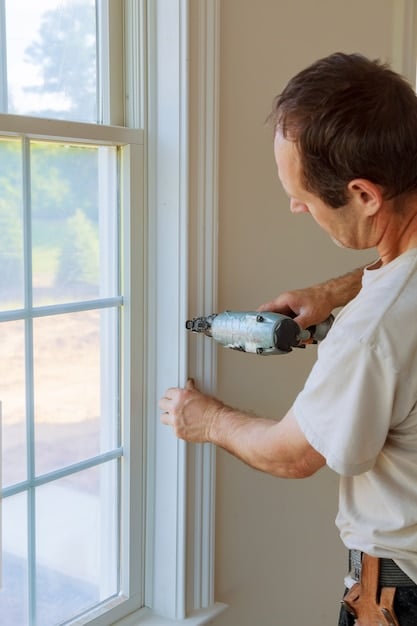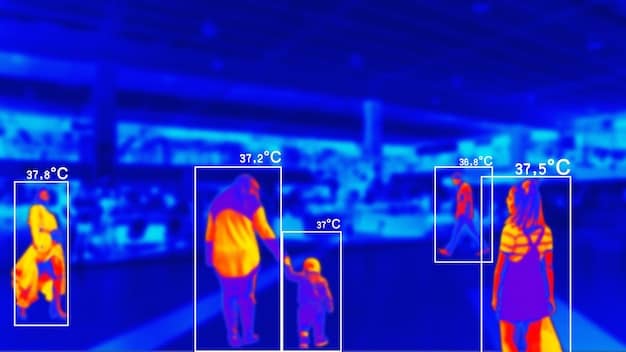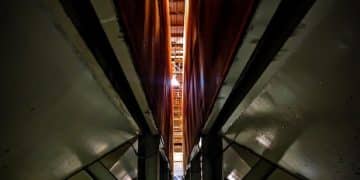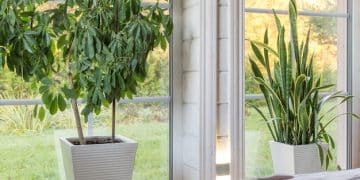Seal Air Leaks: Boost Energy Efficiency & Cut Heating Costs Up to 20%

Increase Your Home’s Energy Efficiency: Seal Air Leaks and Save Up to 20% on Heating Costs through strategic weatherization, focusing on identifying and sealing drafts around windows, doors, and other openings to minimize heat loss and lower your energy bills.
Want to **increase your home’s energy efficiency, seal air leaks and save up to 20% on heating costs**? Sealing air leaks is a straightforward and effective way to reduce energy consumption, lower utility bills, and create a more comfortable living environment.
Understanding Energy Efficiency and Air Leaks
Energy efficiency is crucial for both your wallet and the environment. Homes with poor insulation and numerous air leaks waste energy, leading to higher heating and cooling bills. Identifying and addressing these issues can significantly reduce your energy consumption.
Air leaks occur in various places throughout a home, often around windows, doors, pipes, and electrical outlets. These leaks allow conditioned air to escape and unconditioned air to enter, forcing your heating and cooling systems to work harder.

Common Sources of Air Leaks
Several areas in your home are prone to air leaks. Knowing where to look is the first step in improving your home’s energy efficiency.
- Windows and Doors: Gaps around frames are typical entry points for drafts.
- Pipes and Wiring: Openings where pipes and wires enter the house can be significant sources of air leaks.
- Attic Hatch: Often overlooked, the attic hatch can leak a substantial amount of air if not properly sealed.
- Fireplace Dampers: A poorly sealed damper can allow warm air to escape up the chimney.
Finding these leaks often involves simple visual inspections, feeling for drafts, or using tools like incense sticks to detect air movement. Addressing these leaks can make a noticeable difference in your home’s comfort and energy bills.
In conclusion, understanding the importance of energy efficiency and knowing the common sources of air leaks is the foundational knowledge needed to enhance your home. Taking steps to identify and address these issues will lead to significant improvements in comfort and cost savings.
Essential Tools and Materials for Sealing Air Leaks
Before you start sealing air leaks, it’s essential to gather the right tools and materials. Having everything on hand will make the process smoother and more effective.
The specific tools and materials you’ll need depend on the type of leaks you’re addressing. However, some items are essential for most projects.
Caulk
Caulk is a versatile sealant used for filling gaps around windows, doors, and other stationary objects. Acrylic latex caulk is paintable and suitable for indoor use, while silicone caulk is more durable and water-resistant, ideal for outdoor applications.
Weatherstripping
Weatherstripping is used to seal movable parts like doors and windows. It comes in various materials, including foam, felt, and rubber. Choose the type that best fits the gap size and material of your door or window frame.
- Caulk gun: For applying caulk smoothly and evenly.
- Utility knife: For trimming excess caulk and weatherstripping.
- Measuring tape: To measure the gaps and lengths accurately.
- Screwdriver: To adjust or replace weatherstripping on doors and windows.
Ensuring you have these tools and materials before you start will streamline the process and ensure you can effectively seal air leaks throughout your home. Preparation is key to a successful and energy-efficient outcome.
To summarize, having the right tools and materials is vital for effectively sealing air leaks in your home. Proper preparation ensures that you can address drafts efficiently and achieve lasting results.
Sealing Windows and Doors to Prevent Drafts
Windows and doors are prime culprits for air leaks in many homes. Effectively sealing these areas can significantly reduce drafts and improve energy efficiency.
There are several methods and materials you can use to seal windows and doors, depending on the size and location of the gaps.
Caulking Windows
Caulking is an effective way to seal gaps around window frames. Start by cleaning the area with a damp cloth to remove dirt and debris. Load the caulk gun and apply a smooth, even bead of caulk along the seam where the window frame meets the wall. Use a wet finger or a caulking tool to smooth the caulk and ensure a tight seal.
Applying Weatherstripping to Doors
Weatherstripping helps seal the gaps between the door and the frame. Measure the length of the door frame and cut the weatherstripping to size. Peel off the adhesive backing and carefully apply the weatherstripping along the frame, ensuring it makes good contact with the door when closed.

- Inspect thoroughly: Before sealing, check all windows and doors for visible gaps or damage.
- Use quality materials: Invest in high-quality caulk and weatherstripping for long-lasting results.
- Seal both sides: Don’t forget to seal both the interior and exterior of windows and doors.
Sealing windows and doors effectively can significantly improve your home’s energy efficiency. By addressing these common sources of air leaks, you can create a more comfortable and energy-efficient living environment.
In summary, sealing windows and doors is a critical step in preventing drafts and improving energy efficiency. Proper preparation and the use of appropriate materials will ensure a tight seal, reducing energy waste and improving comfort.
Addressing Air Leaks in Walls, Floors, and Ceilings
While windows and doors are common culprits, air leaks can also occur in walls, floors, and ceilings. These areas, often hidden from plain sight, can contribute significantly to energy loss.
Identifying and sealing these less visible air leaks is essential for maximizing your home’s energy efficiency.
Sealing Around Pipes and Wiring
Gaps around pipes and wiring that enter your home can be significant sources of air leaks. Use caulk or expanding foam to seal these openings. Ensure the area is clean and dry before applying the sealant. Expanding foam is particularly useful for larger gaps, but be careful not to overfill, as it can expand excessively.
Insulating Attic Hatches
Attic hatches are often overlooked but can leak a substantial amount of air. Insulate the attic hatch by attaching rigid foam insulation to the back of the hatch door. Use weatherstripping around the perimeter to create a tight seal when the hatch is closed.
- Inspect regularly: Periodically check these areas during seasonal changes to ensure the seals remain intact.
- Use appropriate sealants: Select sealants that are suitable for the materials being sealed, ensuring longevity and effectiveness.
- Consider professional help: For extensive or hard-to-reach leaks, consider consulting a professional energy auditor or contractor.
Addressing air leaks in walls, floors, and ceilings can be challenging, but it is crucial for comprehensive energy efficiency. By sealing these hidden leaks, you can significantly reduce energy loss and improve your home’s overall comfort.
In short, addressing air leaks in walls, floors, and ceilings improves your home’s energy efficiency. Sealing around pipes and wiring, as well as insulating attic hatches, are effective strategies for reducing energy loss.
Insulating Your Attic for Maximum Energy Savings
The attic is a critical area for energy efficiency. Proper insulation in the attic can help maintain a steady temperature throughout your home, reducing the workload on your heating and cooling systems.
Adequate attic insulation not only saves energy but also helps prevent ice dams during cold weather.
Types of Attic Insulation
There are several types of insulation suitable for attics, each with its own set of benefits. Fiberglass batt insulation is a common and cost-effective option. Loose-fill insulation, such as cellulose or fiberglass, is ideal for filling irregular spaces and can be blown into the attic.
Proper Insulation Techniques
When installing insulation, ensure it is evenly distributed and covers the entire attic floor. Pay special attention to areas around recessed lighting and chimneys, as these can be fire hazards. Use baffles to maintain airflow to the eaves and prevent moisture buildup.
- Check local codes: Ensure your insulation meets local building codes and energy efficiency standards.
- Seal air leaks first: Before insulating, seal any air leaks in the attic to prevent conditioned air from escaping.
- Wear protective gear: Always wear a mask, gloves, and eye protection when handling insulation to avoid irritation.
Insulating your attic is a smart investment in your home’s energy efficiency. By choosing the right type of insulation and installing it correctly, you can achieve significant energy savings and improve your home’s comfort.
In conclusion, insulating your attic is key to maximizing energy savings. By choosing the right insulation type and employing proper installation techniques, you can significantly enhance your home’s energy efficiency and comfort.
Checking and Maintaining Your Home’s Energy Efficiency
Once you’ve sealed air leaks and insulated your home, it’s important to regularly check and maintain these improvements to ensure long-term energy efficiency.
Regular maintenance can help you identify and address new leaks or areas where insulation has deteriorated.
Regular Inspections
Conduct seasonal inspections of your home’s windows, doors, and other potential leak areas. Look for signs of damage, such as cracks in caulk or worn weatherstripping. Use a flashlight to inspect dark corners and hard-to-reach areas.
Energy Audits
Consider scheduling a professional energy audit. Energy auditors use specialized equipment, such as thermal cameras and blower door tests, to identify hidden air leaks and insulation deficiencies. They can provide a detailed report with recommendations for improving your home’s energy efficiency.
- Keep records: Maintain a record of all energy efficiency improvements, including dates, materials used, and costs.
- Monitor energy bills: Track your energy consumption over time to assess the effectiveness of your efforts.
- Address issues promptly: Repair any identified issues promptly to prevent further energy loss.
Checking and maintaining your home’s energy efficiency is an ongoing process. By staying proactive and addressing issues as they arise, you can ensure your home remains energy-efficient and comfortable for years to come.
To summarize, checking and maintaining your home’s energy efficiency involves regular inspections and periodic energy audits. Addressing identified issues promptly will help maintain energy efficiency and comfort.
| Key Point | Brief Description |
|---|---|
| 🏠 Seal Air Leaks | Reduces energy waste and lowers heating/cooling costs. |
| 🛠️ Use Caulk & Weatherstripping | Seal gaps around windows, doors, and pipes. |
| 🌡️ Insulate Attic | Maintains steady temperature and prevents ice dams. |
| 🔍 Regular Checks | Inspect seasonaly for damaged areas and maintain the seals, and audit to keep energy waste minimum. |
Frequently Asked Questions
▼
Sealing air leaks reduces energy waste, lowers utility bills, and creates a more comfortable living environment. Minimizing drafts makes your heating and cooling systems more efficient.
▼
Common areas for air leaks include windows, doors, pipes, wiring penetrations, and attic hatches. These areas often have gaps or cracks that allow air to escape.
▼
Caulk is effective for stationary gaps, while weatherstripping works well for movable parts like doors and windows. Expanding foam can be used for larger gaps around pipes and wiring.
▼
You can test for air leaks by feeling for drafts, using an incense stick to detect air movement, or scheduling a professional energy audit with a thermal camera.
▼
Yes, insulating your attic is highly beneficial for energy efficiency. It helps maintain a consistent temperature, reduces energy consumption, and prevents ice dams during cold weather.
Conclusion
By following these steps to **increase your home’s energy efficiency, seal air leaks and save up to 20% on heating costs**, you can create a more comfortable, energy-efficient, and cost-effective living environment. Taking proactive measures to seal air leaks and properly insulate your home will not only reduce your energy bills but also contribute to a more sustainable future, providing long-term benefits for both you and the environment.





